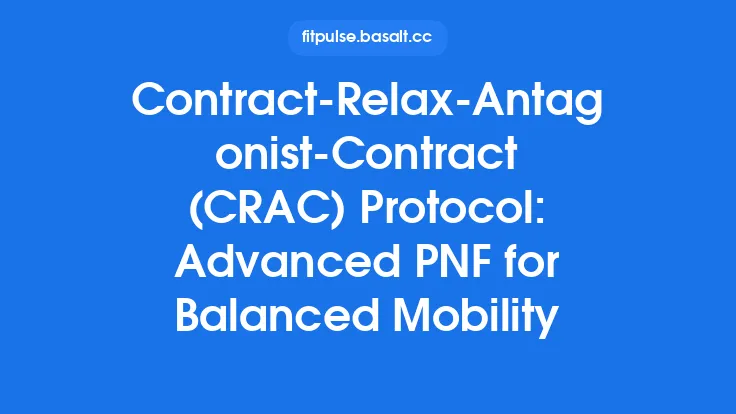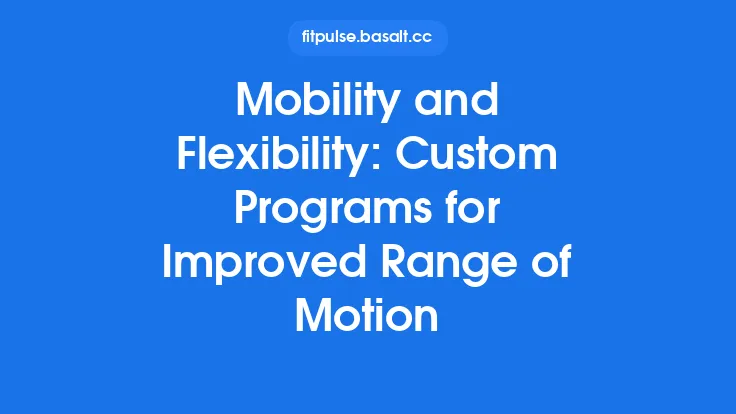The Hold‑Relax (HR) technique is one of the most widely used and time‑tested methods within Proprioceptive Neuromuscular Facilitation (PNF) stretching. By pairing an isometric contraction with a subsequent passive stretch, HR taps into the body’s natural reflex pathways to produce a measurable increase in joint range of motion (ROM). While the concept is simple, mastering the nuances of timing, intensity, and body positioning can turn a basic stretch into a powerful tool for athletes, coaches, and anyone seeking lasting mobility gains.
The Physiology Behind the Hold‑Relax Response (Without Getting Too Deep)
When a muscle is contracted isometrically, the Golgi tendon organs (GTOs) located at the muscle‑tendon junction sense the increase in tension. After a brief period (typically 5–7 seconds), the GTOs trigger an autogenic inhibition response, temporarily reducing the excitatory drive to the same muscle. This “relaxation window” allows the muscle fibers to lengthen more easily when a gentle stretch is applied immediately afterward. The HR method leverages this reflex to achieve a stretch that exceeds what passive stretching alone can accomplish.
Core Components of an Effective Hold‑Relax Stretch
| Component | Recommended Practice | Why It Matters |
|---|---|---|
| Isometric Contraction Duration | 5–7 seconds (max 10 seconds) | Sufficient to activate GTOs without causing fatigue or excessive motor unit recruitment. |
| Contraction Intensity | 20–30 % of maximal voluntary contraction (MVC) for beginners; up to 50 % MVC for advanced practitioners | Low‑to‑moderate intensity is enough to trigger inhibition while keeping the joint safe. |
| Relaxation Phase | Immediate passive stretch held for 15–30 seconds | The muscle is most receptive to lengthening right after the contraction. |
| Repetitions | 2–3 cycles per session per muscle group | Repeated cycles reinforce the inhibitory effect and consolidate ROM gains. |
| Rest Between Cycles | 20–30 seconds of light movement or breathing | Allows the neuromuscular system to reset, preventing cumulative fatigue. |
Step‑by‑Step Execution Guide
- Position the Target Muscle
- Align the joint so that the muscle is in a comfortable, slightly stretched position (e.g., for the hamstrings, lie supine with the leg raised to a 30‑degree hip flexion).
- Ensure the antagonist muscle is relaxed; this reduces reciprocal inhibition that could counteract the HR effect.
- Establish a Baseline Stretch
- Gently move the limb into a passive stretch that is tolerable but not painful. This is the “pre‑stretch” that will be deepened later.
- Apply the Isometric Contraction
- Instruct the client (or yourself) to push against an immovable object (e.g., a partner’s hand, a wall, or a strap) without actually moving the joint.
- Maintain the contraction for 5–7 seconds, focusing on a steady, controlled effort.
- Release and Deepen the Stretch
- As soon as the timer ends, tell the client to relax completely.
- Immediately increase the stretch by a small, comfortable amount (typically 5‑10 % more joint angle) and hold for 15–30 seconds.
- Repeat the Cycle
- Return the limb to the baseline stretch and repeat steps 3‑4 for a total of 2–3 cycles.
- Record the final joint angle to track progress.
Solo vs. Partnered Hold‑Relax
| Situation | Solo Adaptation | Partnered Adaptation |
|---|---|---|
| Equipment | Use a resistance band or a sturdy strap anchored to a fixed point. Pull against the band while keeping the joint stationary. | Partner provides a hand or forearm as a stable “wall” for the isometric push. |
| Feedback | Rely on visual cues (mirror) or a goniometer app to gauge stretch depth. | Partner can feel the contraction intensity and give verbal cues (“push harder,” “relax now”). |
| Safety | Ensure the anchor point is secure; avoid sudden jerks. | Partner should maintain a firm but non‑overpowering resistance to prevent joint overload. |
Both approaches are valid; the choice depends on training environment, available equipment, and personal preference.
Programming the Hold‑Relax Method
| Variable | Beginner | Intermediate | Advanced |
|---|---|---|---|
| Frequency | 2 sessions per week per muscle group | 3 sessions per week | 3–4 sessions per week, possibly split across days |
| Volume | 2 cycles per muscle, 15‑second stretch | 3 cycles, 20‑second stretch | 3–4 cycles, 30‑second stretch |
| Intensity | 20 % MVC (light push) | 30‑40 % MVC | 50 % MVC (controlled, strong push) |
| Progression | Increase stretch angle by 2‑3° each week | Add an extra cycle or extend stretch hold by 5 seconds | Combine HR with a brief dynamic warm‑up to pre‑activate the muscle before the isometric phase |
Key programming tip: Always allow at least 48 hours before re‑targeting the same muscle group with HR to respect the neuromuscular recovery window.
Common Technical Pitfalls and How to Fix Them
| Pitfall | Symptom | Correction |
|---|---|---|
| Holding the stretch too far before the contraction | Minimal ROM gain, discomfort | Keep the pre‑stretch within a comfortable range (≈30 % of maximal stretch) before the isometric phase. |
| Excessive contraction intensity | Joint strain, post‑stretch soreness | Use a perceived exertion scale (1–10); aim for 3–4/10 for beginners, 5–6/10 for advanced. |
| Skipping the immediate stretch after release | Diminished autogenic inhibition effect | Set a timer to cue the transition; the stretch must follow within 1–2 seconds of relaxation. |
| Inconsistent breathing | Increased muscle tension, reduced relaxation | Inhale during the isometric hold, exhale fully during the stretch phase. |
| Neglecting antagonist relaxation | Reciprocal inhibition counteracts HR | Actively cue the opposite muscle group to stay loose (e.g., relax quadriceps when stretching hamstrings). |
Integrating Hold‑Relax with Complementary Mobility Work
While HR is a potent standalone technique, it can be strategically paired with other mobility tools to create a balanced session:
- Dynamic Warm‑Up (5‑10 min) – Light joint circles, bodyweight movements, or mobility drills to raise tissue temperature.
- Active Range of Motion (AROM) Drills (2‑3 min) – Controlled limb movements that reinforce motor patterns before HR.
- Hold‑Relax Cycles (10‑15 min) – Follow the step‑by‑step protocol for the target muscle groups.
- Post‑HR Static Hold (2‑3 min) – A gentle, non‑intense static stretch to “lock‑in” the new ROM.
- Movement Integration (5‑10 min) – Functional patterns (e.g., squat, lunge) that incorporate the newly gained flexibility.
This sequencing ensures that HR is performed on warmed‑up tissue, maximizes neural receptivity, and translates the flexibility gains into functional movement.
Frequently Asked Questions
Q: How long does a typical ROM improvement last after a Hold‑Relax session?
A: Acute gains can be observed immediately and may persist for 24‑48 hours. Consistent training (2–3 sessions per week) leads to lasting adaptations over 4–6 weeks.
Q: Can I use Hold‑Relax on joints with limited mobility due to arthritis?
A: Yes, provided the intensity is kept low (≈15‑20 % MVC) and the stretch range stays within pain‑free limits. Always consult a healthcare professional for joint‑specific concerns.
Q: Is it safe to perform Hold‑Relax on the same day as heavy strength training?
A: It is generally safe, but schedule HR after the main strength work or on a separate session to avoid compromising performance due to temporary muscle inhibition.
Q: Do I need a partner for optimal results?
A: A partner can provide more precise resistance and feedback, but a well‑anchored strap or resistance band can deliver comparable outcomes when used correctly.
Q: How do I measure progress objectively?
A: Use a goniometer, inclinometer app, or tape‑measure (for linear stretch) to record joint angles before and after each session. Track changes weekly to gauge trends.
Closing Thoughts
The Hold‑Relax method remains a cornerstone of PNF stretching because it blends a simple neuromuscular principle with a practical, repeatable protocol. By respecting the timing of the isometric contraction, calibrating intensity, and following a disciplined repetition scheme, practitioners can unlock meaningful, sustainable improvements in joint range of motion. Whether you are an athlete fine‑tuning performance, a coach designing a mobility curriculum, or an individual seeking everyday comfort, mastering Hold‑Relax offers a reliable pathway to greater flexibility without the need for complex equipment or advanced training knowledge.





